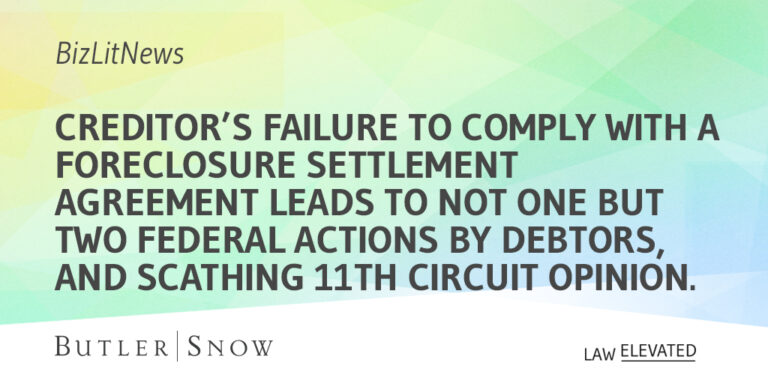In a murderer’s row of what not to do as a mortgage creditor, the 11th Circuit recently reversed summary judgment in favor of a creditor for alleged violations of the Fair Credit Reporting Act (“FCRA”), Florida Consumer Collection Practices Act (“FCCPA”), and breach of contract. Marchisio v. Carrington Mtg. Svcs., LLC, No. 17-10584 (11th Cir. Mar 25, 2019). The creditor’s actions led to not one but two federal actions by the debtors. The facts are quite troubling and include a laundry list of “no-no’s” committed by the creditor Carrington, so bear with me as I recap the story.
The saga began in 2009, when Carrington brought a foreclosure suit against the Marchisios. That case settled when the Marchisios relinquished the property, and Carrington agreed to extinguish the debts related to the property. Here is where things “went South” for Carrington. In violation of the agreement, Carrington failed to report the correct status of the extinguished debts (no-no #1). And it continued trying to collect the extinguished debts from the Marchisios (no-no #2). This conduct led the Marchisios to file their first federal suit against Carrington.
The first suit was eventually settled, with Carrington agreeing to correct its reporting of the loan status and paying the Marchisios $125,000. Carrington, however, failed to report the loan as zero balance as required and, in fact, continued to improperly report the debt (no-no #3). Even after finally reporting a zero balance, Carrington still incorrectly reported that the Marchisios owed a balloon payment on the debt (no-no #4). Then, (and it is never a good sign when an appellate court writes, “If that wasn’t bad enough….”) Carrington added forced-placed insurance on the property. Keep in mind this is property that the Marchisios had given up years prior, and Carrington began charging them for the premiums (no-no’s #5 and 6).
Needless to say, Carrington’s actions led the Marchisios to file a second federal suit alleging three claims: violations of FCRA, FCCPA, and breach of contract. Both sides moved for summary judgment. The district court granted the Marchisios’ motion as to part of the FCRA claim and awarded statutory damages and attorney’s fees,but denied the Marchisios’ request for emotional distress and punitive damages. The district court also granted Carrington’s motion for summary judgment as to the FCCPA and breach of contract claims.
In a scathing opinion, the 11th Circuit reversed the district court on almost everything, including the court’s granting summary judgment on the Marchisios’ emotional distress and punitive damages claims. The 11th Circuit also vacated the award of attorney’s fees for recalculation at the conclusion of the litigation. In telling language, the court noted that the original attorney’s fee award to the Marchisios should represent a “floor” when the attorney’s fees are recalculated.
Throughout the 60 page opinion, the 11th Circuit took Carrington to task for its handling of the debt reporting. The Court concluded that Carrington “failed to conduct a reasonable investigation” and that Carrington’s conduct was so egregious as to rise to the level of “reckless” conduct under FCRA. The Court went further and found that the Marchisios had established a question of fact on the issue of whether they suffered emotional distress as a result of Carrington’s conduct.
More significantly, the 11th Circuit reversed the district court’s grant of summary judgment as to punitive damages, ruling that “punitive damages are not precluded as a matter of law.” The Court found no authority to support Carrington’s contention that intentional conduct was needed to support punitive damages, and remanded for the district court to “allow factual development of this issue [punitive damages] at trial.”
The opinion explores Carrington’s internal procedures for debt reporting ad nauseum. Suffice it to say that the Court found the procedures woefully inadequate. “Thus, by the end of January 2014, more than four years after settlement of the foreclosure action and prompted only by two subsequent lawsuits, Defendant finally managed to update its databases, correct its previous errors, and accurately report the status of Plaintiffs’ second loan.”
As the saying goes, “bad facts make bad law”. When it comes to debt reporting and compliance with the FCRA, the facts don’t get much worse than this.
Authored by: A. David Fawal
